
Kashfi, P., Feldt, R., & Nilsson, A. (2019). Integrating UX principles and practices into software development organizations: A case study of influencing events. Journal of Systems and Software, 154, 37-58. doi:10.1016/j.jss.2019.03.066
By Pariya Kashfi, Robert Feldt , Agneta Nilsson
July 3, 2020
Introduction
- UX principles and practices help “deliver an overall appealing UX”
- Example of UX principle = “UX is dynamic and changes over time”
- Example of UX practice = “identify users’ emotional requirements”
- This study raises importance of UX being most impactful when integrated early in the development process
- UX designers share a struggle to integrate the UX process early in development because it requires the development process to slow down
- There are no prescribed ways to use UX tools and methods in development, and not all members across the organization understand the concept of UX in the software industry
- Various studies have been done to “report on challenges and success factors for usability and UX integration”
- By understanding how UX can be integrated, the studies will help improve the production of software development
- Research gap: studies do not investigate/reflect on the transitionary process that companies go through when adopting UX methods and practices
- Q: How do you explain UX to non-designers in your team?
- Q: Have you ever had to try and make the UX process happen earlier in the software development process?
- Q: What kinds of UX issues do you talk about with your co-workers?
- Value / Outcome of research: Researchers and practitioners that want to know better ways of integrating UX in organizations will find value in this research. “This knowledge can help the community to learn from, apply, or customize and extend the existing ways to improve integration in other contexts”, that suits their organizations
- Similarly, the value of my research can extend to other emerging professions in the software industry by examining the way they steward knowledge in their practice
- Research question: How does UX integration unfold over time within the context of an organization? And what are the main intertwining events that impact UX integration as it unfolds?
- Structure of paper:
- Section 1 intro
- Section 2 literary review
- Section 3 research methods
- Section 4 findings
- Section 5 discussion and implications of findings
- Section 6 concluding remarks and future directions of research
Background
- Authors draws clear line between usability and user experience
- UX has five unique characteristics:
- Subjective; relies on human perception
- Holistic; contains hedonic and pragmatic aspects of use
- Dynamic; changes over time
- Context-dependent
- Worthwhile; leads to positive and meaningful consequences
- Principles and practices are used to increase the chances of providing the desired characteristics
- Practices are done to fulfil the UX principles
- Note: Why do the authors go so deep into clarifying usability and UX? I think it’s because the integration of usability is an entirely different topic of study than their focus which is on the integration of user experience
- “Practitioners still do not have access to standards or agreed upon lists of principles and practices that can support delivering a good UX through the developed software”
- I like how the authors summarize the insights they gathered in literature review:
- Short comings in literature:
- UX and usability is not clearly differentiated in literature and how they impact work
- Studies focus on how UX is perceived in the industry and does not focus on the challenges that practitioners face (ex. communication and collaboration between UX and non-UX practitioners)
- UX studies focus on how they are perceived by the industry without focusing on what is really going on with the communication and collaboration challenges within organizations
- Studies do not explore transition of UX integration
- Longitudinal studies do not clearly differentiate usability and UCD from UX
- Then, the authors go on to summarize the handful of longitudinal studies they did find
- Authors repeat how these studies do not differentiate usability from UX
- Note: This is a concern that authors repeat because it helps raise the important of their study which does differentiate UX. They’ve already explained why UX is different usability with reference to literature, so this argument is strong.
- Note: Elaborating on similar longitudinal studies also shows how this study supports existing research. I also need to elaborate on literature that my research directly supports (ex. Kou, Gray).
Research Method
- Case study using longitudinal (retrospective) data
- Grounded Theory analysis
- “popular method in various fields including software engineering and development as it is suitable for investigating ‘what is going on’ and generating new theories rather than verifying an existing theory ( Stol et al., 2016 ).”
- Benefits of GT also suited the research aim
- I can provide something like this too, to back up the reason why I am using GT
- Methodology to investigate the evolution of complex phenomena over time
- Facilitates addressing research questions over time
- Reduces the risk that the findings only reflect transient phenomenon
- Case company: Medium-sized international software development company in Sweden
- Do I have to hide company names?
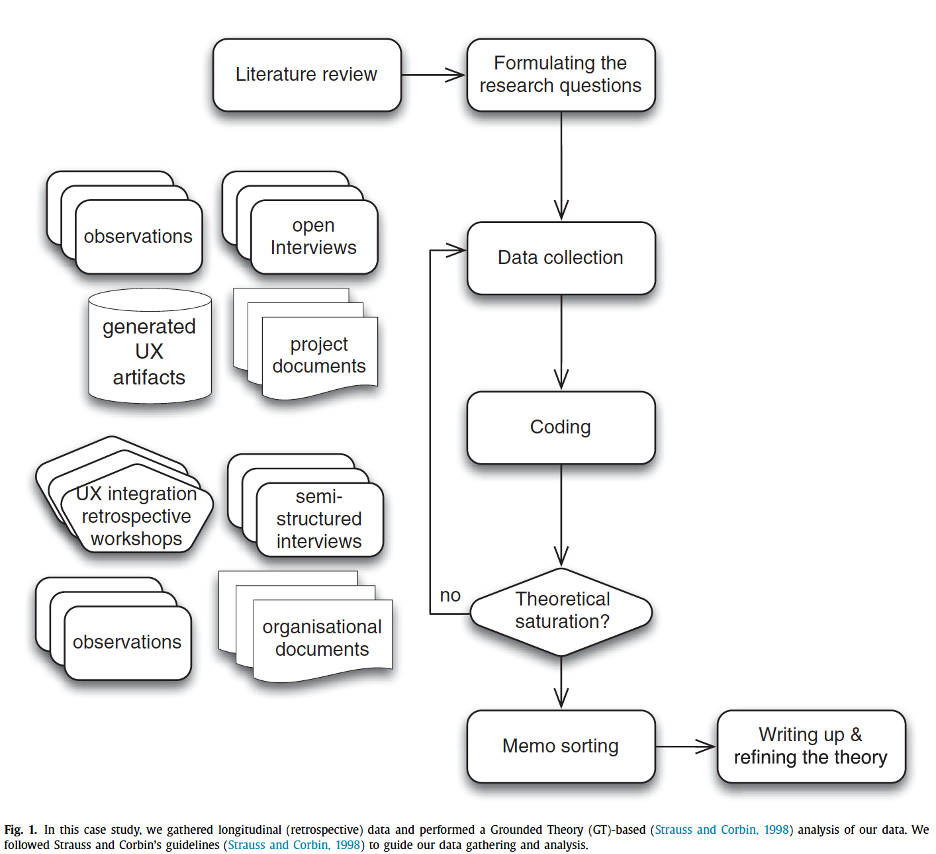
- Authors describe why the case company was ideal for the aims of this research
- Authors describe the structure of the company and how teams are structured for projects
- This company has a UX guild – CoP
Data Collection
- Data gathering was done through a collection of empirical methods
- Observations, interviews, document analysis, workshops
- For the sake of completing mine on time, I will stick to interviews
- Authors got to sit-in on guild meetings – CoP
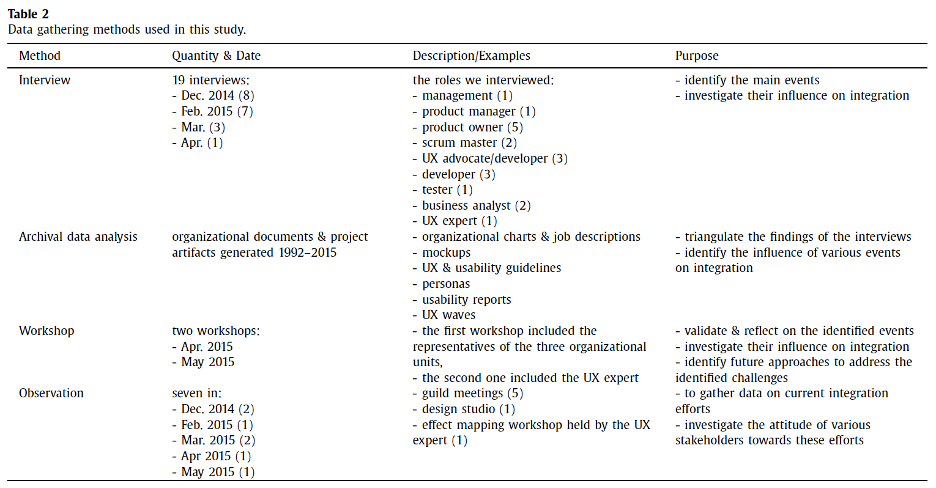
Data Analysis
- Note: Authors chose to analyze their data using the Straussian without explaining WHY or HOW
- Note: The authors then go into describing the steps of analysis and include the definition of each method too
- Open coding done on raw data – 143 codes
- Axial coding – 27 categories, 3 main themes
- Examples of themes: “UX practices and responsibilities, internal and external stakeholders’ beliefs and attitude about software quality and UX, and the company’s business model and strategy and how UX integration was perceived in relation to that”
- “Sub-themes: managing UX practices, the role of politics in integration, the role of power-relations in integration, the relation of UX to GUI design and development, the importance of software quality in general and UX in particular, the importance of the end user needs’ compared to the needs of customers, the relation of integration to value delivery, and UX being part of the business model and strategy of the organization”
- “Further analysis of the identified categories and their impact on integration over the years showed that they spread over at least four noticeable time periods that reflect the paradigm shifts in the organization in particular in relation to the main three identified themes”
- Led to the development of distinct time periods that encompass the company’s transitions to integrate UX
- Selective coding – selecting a core category from main categories identified in axial coding, and then linking identified categories to the core category
- Ok, so it looks like the Straussian version (Strauss and Corbin) is the method I will use too; it seems doable and suitable for what I hope to find
- Results: 4 lessons learned and 5 pitfalls
- The authors make it explicit that they will describe their analysis as a narrative
- Their narrative is not about the cause and effect relationships in the data. They talk about what improves or worsens the integration of UX
- How would my narrative be told without it falling into the conventional story of cause and effect?
- Ex. what enables knowledge sharing and what doesn’t?
Results
- The authors framed their analysis along 4 time periods based on the categories that formed while collecting and analysing data; I too will find a structure to frame the analysis as I conduct the research. This framework would have a direct relationship to the categories
- The four time periods:
- Period one: focusing on graphical user interfaces
- Period two: initiating usability integration
- Period three: initiating UX integration
- Period four: improving UX integration
- Example of how categories were organized by period:
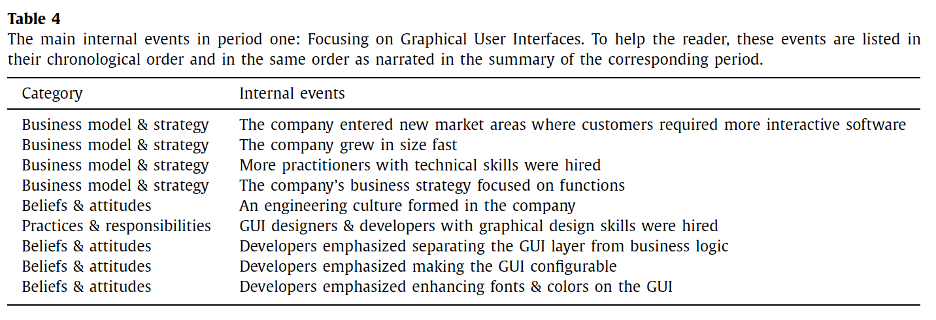
- Each period contains anecdotes (quotes) to support the claims described
Discussion
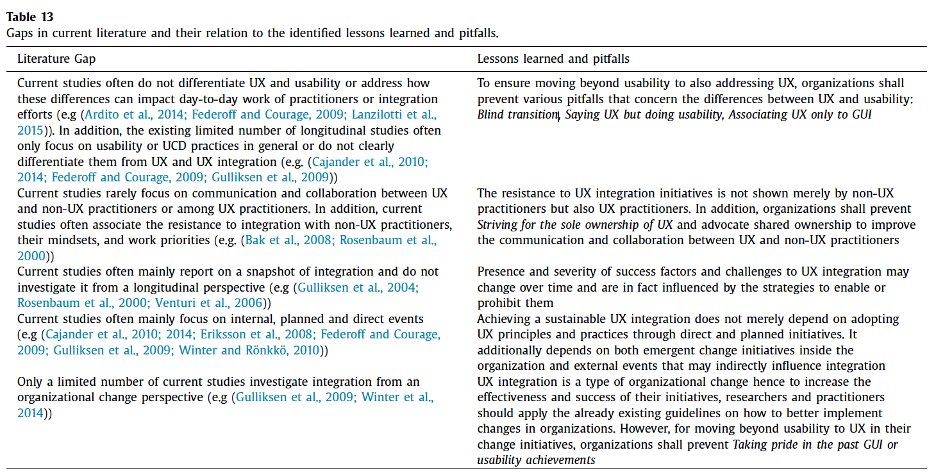
- The authors connect lessons learned to the research gaps identified in literature review:
- They “bridge existing gaps in current literature on UX integration”
- Does seem a little too linear though; very “engineer” like

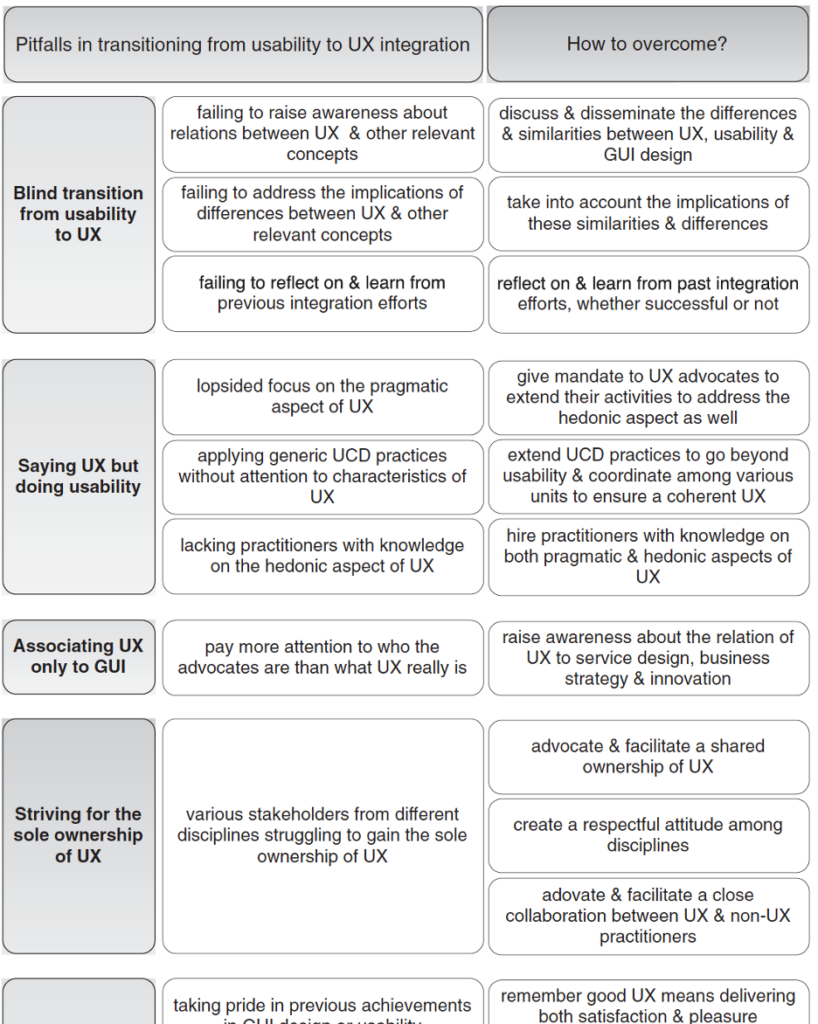
Limitations and threats to validity
- I think this is something I can come to later…